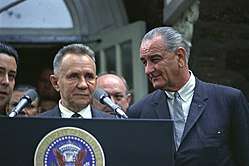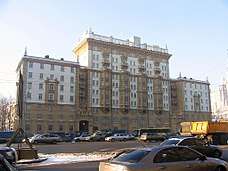Moscow Signal
The Moscow Signal was a reported microwave transmission varying between 2.5 and 4 gigahertz, directed at the Embassy of the United States, Moscow from 1953–1976, resulting in an international incident. The US government eventually determined it was probably an attempt at espionage, and that there were no significant health effects on embassy staff.
Background
The name "Moscow Signal" was used by United States intelligence officials[1] to describe the low power frequencies recorded in the embassy. The microwave transmissions were only five microwatts per square centimetre,[1] which is well below the power level of microwave ovens, and well below what would be needed to heat anything.[2] However, the frequencies were a hundred times more powerful than the Soviets’ maximum exposure standards,[1] which caused concern among U.S. officials.
The microwave beam came from a source in a Soviet apartment building about 100 metres west of the 10-floor embassy building. The beams targeted the west side of the building, with highest intensities between the third and eighth floors.[3]
During routine background radiation testing in 1953, the microwaves were detected and sourced to suspected Soviet forces.[3] Eleven years later, shielding against the microwaves was eventually put into place.[2] During regular monitoring of the signal, the beams were found to have increased in intensity in 1975.[3] The discovery of these microwaves was kept secret from the public and even from individuals who had worked in the embassy during the period of suspicion that the microwaves had been directed there.
There are many possible reasons the Soviet Union would have for directing the microwave transmissions at the United States Embassy. Among these possibilities is the most likely theory that the microwave transmissions were used to trigger eavesdropping technology on U.S. intelligence operations.[2] Other theories include electronic jamming and a popular, although un-proven, school of thought that the technology was used to interfere with the health, minds or behaviour of the American embassy staff.[2]
Consequences
United States human testing
In minutes from a May 12, 1969, meeting, the DARPA Pandora scientific committee discussed plans to move forward with eight human subjects.[1] The human subjects would be exposed to the Moscow Signal and then given a full battery of medical and psychological tests. The committee did recommend "gonadal protection be provided" to the male test subjects, however, human testing was not pursued. The program was shut down in 1969, with an effect of the signal on behavior and/or biological functions deemed "too subtle or insignificant to be evident".[1]
Moscow embassy study
In 1976, after the microwave radiation was found to have increased, the U.S. Department of State commissioned a study led by Abraham Lilienfeld, assisted by the Department of Epidemiology at Johns Hopkins University. [3] The goal of the study was to compare the Moscow embassy staff and their families with the staff and families associated with other eastern European U.S. embassies, who would have shared many similarities in their daily life. The exposed group were staff who had worked at the Moscow embassy from January 1, 1953 to June 30, 1976, and their families in Moscow; and the comparison group was individuals in other selected Eastern European embassies during the identical timeframe, and their families. While the study was unpublished, its 1978 report concluded that there were no adverse health effects.[3]
American paranoia: "The Zapping of America"
After the news of the Moscow Signal broke to the public, many Americans became afraid of the "invisible threat", something they could not see but feared could kill them. Author Paul Brodeur first warned Americans of the danger of "invisible threats" in the form of a list of environmental hazards to human life, which included "detergent enzymes, cancer-causing asbestos fibers, and ozone-depleting fluorocarbons in spray cans."[4] In Brodeur's book The Zapping of America, he claims that Americans are exposed to lethal levels of radiation from missile-tracking radars, television transmitters and even the common household microwave oven.[4] In an interview with People Magazine, Brodeur explains that although the United States maximum exposure standard is 10 milliwatts per square centimeter,[5] that standard is unenforceable. As well, he claims that there have been multiple animal experiments which resulted in "changes in brain chemistry and the central nervous system, abnormalities of the blood-forming systems and birth defects."[4] Later in the interview he cautions that the amount of radiation that the average household microwave oven leaks is "500 times higher than Eastern European and Soviet standards for worker exposure and 5,000 times the recommended limits for the general population."[4] Concerns arose from Americans that microwaves could be used as a weapon for behavior modification, or even mind control.[1] What may have started out as a "tin-foil hat" theory,[1] soon spiralled into full-blown paranoia that gave birth to many suspicions some still hold to this day, such as not to watch food while it warms up in the microwave.[4]
Relation to the Cold War
Technological advancement
The Cold War is believed to have begun with the signing of the Truman Doctrine, which threatened Soviet communist and expansionist policies and ideologies. The term "cold" is used to describe this war as there was no actual large-scale fighting between the two major powers involved, the United States and the Soviet Union. The Cold War was fought as an arms race and relied on espionage to cause damage to the opposing country. The Moscow Signal was used during the period of The Cold War commonly referred to as "Confrontation Through Détente". The signal is just one example of the new technologies developed during The Cold War to be used to spy on the transmissions of other countries without needing a human intelligence agent. Cold War espionage was ruthless and drastically changed international relations. In cases like the Moscow Signal, the health of individuals was potentially put at risk by new and untested technologies, and this was often the case in the Cold War.

The Glassboro Summit of 1967
The Glassboro Summit Conference was held in June 1967. It was a meeting of President Lyndon B. Johnson and Premier Alexei Kosygin, leaders of the United States government and Soviet government, respectively—for the purpose of discussing Soviet Union–United States relations. It was held in Glassboro, New Jersey. During the course of this meeting, the United States made several protests to the Kremlin over the use of microwave technology.[2] However, the protests were unsuccessful as the microwave technology was used on the United States embassy in Moscow for several years to come.[2]
See also
References
- "The Secret History of Diplomats and Invisible Weapons". Foreign Policy. Retrieved 2018-05-11.
- Reppert, Barton (May 22, 1988). "Zapping an Embassy: 35 years later, the mystery lingers". Times Daily. Retrieved 2018-05-14.
- Elwood JM (November 2012). "Microwaves in the cold war: the Moscow embassy study and its interpretation. Review of a retrospective cohort study". Environmental Health. 11: 85. doi:10.1186/1476-069X-11-85. PMC 3509929. PMID 23151144.
- Jerome, Jim (January 30, 1978). "The Microwave Menace Is Zapping Us All, Warns Writer Paul Brodeur". People Magazine. Retrieved 2018-05-21.
- Brodeur, Paul (1977). The Zapping of America: Microwaves, Their Deadly Risk, and the Coverup. W W Norton & Co Inc. ISBN 978-0393064278.
